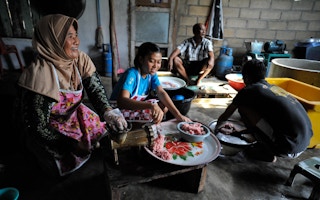It is heartening to see signs that Southeast Asia is taking the threats of climate change and the importance of the renewable energy transition more seriously. According to the Southeast Asia Climate Outlook survey published by Singapore’s ISEAS – Yusof Ishak Institute in 2021, 70 per cent of respondents in Asean countries believed that climate change posed a “serious and immediate threat” to the well-being of their countries. Although Asean countries are expected to continue to rely on fossil fuels — the primary source of greenhouse gas emissions — in the near future, there are at least modest regional targets to increase the percentage of renewable energy in the region’s total energy supply.
Southeast Asians should continue to pressure their governments to intensify energy transition efforts. However, they should also consider whether energy transition plans will leave anyone too far behind. The United Nation’s Sustainable Development Goal 7 (SDG7) — to ensure access to affordable, reliable, sustainable and modern energy for all — should be one of the main guiding principles of Asean’s energy transition.
Energy access includes access to electricity and clean cooking fuels and technologies. According to the Tracking SDG7: The Energy Progress Report published in 2022, 91 per cent of the world’s population had access to electricity and 69 per cent had access to clean cooking fuels and technologies in 2020. Clean cooking fuels include, for example, electricity, biogas, solar, liquefied petroleum gas (LPG) and ethanol. This means that 733 million people worldwide still do not have access to electricity. More appallingly, 2.4 billion people — a third of the world’s population — have no access to clean cooking and instead rely on pollutive fuels such as wood, charcoal, kerosene and dung.
Pollutive cooking fuels exacerbate global warming because they emit greenhouse gases such as methane and carbon dioxide. Collecting wood products for fuels has also been linked to deforestation. Moreover, such fuels cause indoor air pollution with serious health effects, including increased risks of respiratory infections, lung cancer and heart disease. In many countries, women and children suffer more of these negative health consequences than other household members since they spend more time in the kitchen or home. This issue is interconnected with food security, access to clean water and poverty. The World Food Programme (WFP) has noted that the absence of affordable fuels has forced many households to barter some of their food for fuels or to undercook and/or skip meals altogether.
To promote universal access to clean cooking and to advance the goals of climate change mitigation and energy transitions, policymakers need to increase commitments to supporting renewable energy options.
The energy access situation in Southeast Asia is not as worrying as in Sub-Saharan Africa where only 48 per cent of the population had access to electricity in 2020, but there are significant disparities within the region. According to a report published by the United Nations ESCAP in 2020, 95.5 per cent of Asean’s population had electricity access in 2018. Of the 29 million people who lacked electricity access, the majority (90 per cent) lived in rural areas and more than half (62 per cent) resided in Myanmar.
More concerning is the fact that only 66.5 per cent of Asean’s population had access to clean cooking fuels and technologies. This means that 219 million people in Aseancountries (33.5 per cent) relied on pollutive cooking fuels as of 2018. Although countries such as Singapore and Brunei had already achieved universal access to clean cooking fuels by 2018 (Malaysia was close behind at 97 per cent), four countries had access levels below 50 per cent, namely Laos (7 per cent), Cambodia (20 per cent), Myanmar (21 per cent) and the Philippines (44 per cent). The same UN ESCAP report suggests that in 2016 around 345,000 people in the Asean region (0.05 per cent of the total population) died prematurely due to negative health effects from using pollutive fuels for cooking and heating.
To promote universal access to clean cooking and to advance the goals of climate change mitigation and energy transitions, policymakers need to increase commitments to supporting renewable energy options. As discussed in the World Health Organisation household energy policy repository, renewable cooking fuels and technologies include biogas, ethanol stoves, solar cookers and electric cooking powered by renewable energy.
However, transition fuels such as liquified petroleum gas (LPG) should not be ruled out. It has been suggested that LPG can help to raise access to clean cooking rather quickly because it is simple to use, portable and easy to distribute. Although still a fossil fuel, it burns more cleanly and has lower emissions compared to pollutive fuels. Notably, Indonesia’s ‘kerosene-to-LPG’ programme has significantly helped to raise Indonesians’ access to clean cooking from 6 per cent in 2000 to 80 per cent in 2018. The Biogas Rumah (BIRU) or ‘biogas for the home’ programme, which has been implemented by an Indonesian non-governmental organisation called Rumah Energi since 2012, is also an excellent initiative that promotes renewable energy and empowers women. Generally, policymakers should promote fuels and technologies that are relatively affordable, easy to use and repair, and also meet the WHO’s health standards (see more policy suggestions here).
It is concerning that the governments of Laos, Cambodia, Myanmar and the Philippines have so far shown little commitment to promoting universal access to clean cooking. At the current rate, UN ESCAP has suggested that the Asean region is unlikely to meet the SDG7 target of universal energy access by 2030. SDG7 should form an important part of Southeast Asian governments’ policies to promote sustainable energy transitions. In the future, Asean will need to commit much higher levels of investment to promote universal access to electricity and clean cooking fuels in the region.
This article was first published by ISEAS – Yusof Ishak Institute as a Fulcrum commentary.











